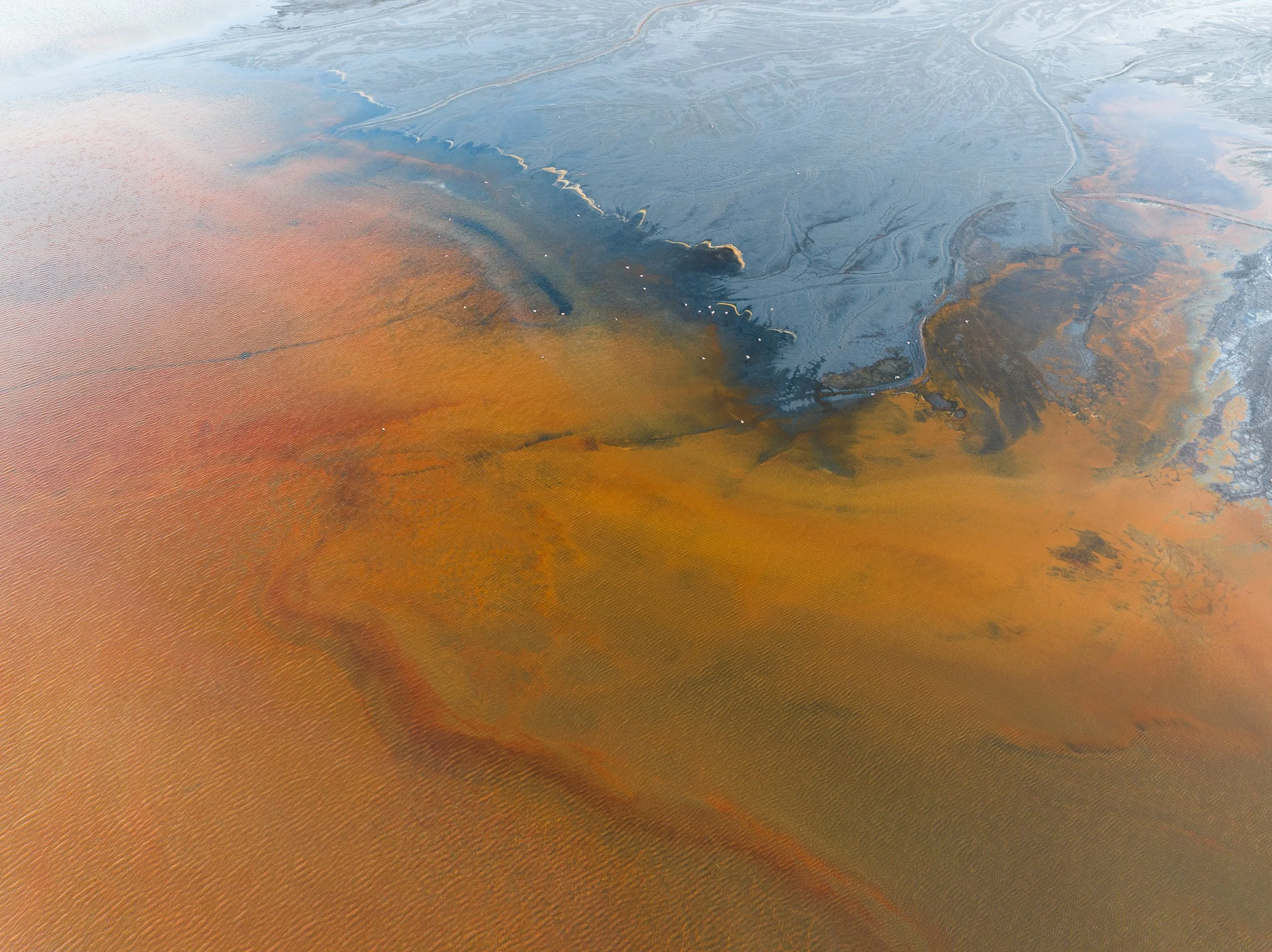Terraforma
Observing the Earth from above reveals perspectives that often go unnoticed in our day-to-day lives. Our normal view, accustomed to the horizontal, is challenged by the aerial perspective, capable of transforming familiar landscapes into abstract patterns in unexpected places. This is frequently the case with mine drainage basins, sites that, at first glance, might only evoke the idea of environmental impact, but which, seen from above, transform into a world of colour and sensory abstraction.
Sedimentation areas form patches of colour and texture; scale disappears or becomes irrelevant; what matters is the visual composition and the relationship between the elements.
Mines are, by nature, aggressive sites with a strong environmental impact. This process, fundamental to our society, leaves marks on the landscape. One of the most visible and, paradoxically, most colourful marks is the drainage basins. These "lakes" are created to receive and treat the water that drains from mining areas, water that carries dissolved minerals with it.
It is here that science meets "art", and environmental impact takes on aesthetic contours, sometimes complex. The intense colour of these basins is not artificial; it is the direct result of chemical processes and the accumulation of different minerals over time. Iron, for example, is largely responsible for the reddish and orange tones that often dominate these landscapes. Copper can bring blues and greens, while other metallic elements and chemical compounds contribute to a surprisingly varied colour palette.
Each drainage basin tells a different geological and chemical story. The intensity of the colours, the different tones that mix and separate, the textures created by sedimentation and by the management of the water and evaporation itself. All of this has the potential to create unique, dynamic patterns that change with the light, the weather, and, of course, the intensity of the mining activity itself.
Subtracting the environmental perspective, there is an undeniable aesthetic dimension to these places. And this is where photography, particularly aerial photography, finds fertile ground. The view from above allows for a reading of the landscape that lets us disconnect from reality. We stop seeing "just" a drainage basin and begin to see lines, shapes, textures, and, above all, colours that interact with each other.
Abstraction in photography does not mean disconnecting from reality, but rather interpreting it in a way that prioritises emotion and personal interpretation.
It is within this context that the "work" I have been developing, and which I have titled "Terraforma", fits. The images that are part of this gallery, and those that I share with you here, are a way of looking at these landscapes in a different light. They are images captured from the air, where abstraction dominates. I focus on the shapes, colours, and textures that transform these places marked by human action into something where personal interpretation is paramount.
Observar a Terra de cima revela perspetivas que, no dia a dia, nos passam despercebidas. O nosso normal, habituado à horizontalidade, é desafiado pela visão aérea, capaz de transformar paisagens familiares em padrões abstratos em locais inesperados. É o que acontece frequentemente com as bacias de drenagem das minas, locais que, à primeira vista, podem evocar apenas a ideia de impacto ambiental, mas que, vistos de cima, se transformam num mundo de cor e abstração sensorial.
As áreas de sedimentação formam manchas de cor e textura, a escala desaparece ou torna-se irrelevante, o que importa é a composição visual e a relação entre os elementos.
As minas são, por natureza, locais agressivos com um forte impacto ambiental. Este processo, fundamental para a nossa sociedade, deixa marcas na paisagem. Uma das marcas mais visíveis e, paradoxalmente, mais coloridas, são as bacias de drenagem. Estes “lagos” são criados para receber e tratar as águas que escorrem das zonas de exploração mineira, águas essas que arrastam consigo minerais dissolvidos.
É aqui que a ciência se encontra com a “arte”, e o impacto ambiental ganha contornos estéticos, por vezes complexos. A cor intensa destas bacias não é artificial, é o resultado direto de processos químicos e da acumulação de diferentes minerais ao longo do tempo. O ferro, por exemplo, é um dos grandes responsáveis pelos tons avermelhados e alaranjados que muitas vezes dominam estas paisagens. O cobre pode trazer azuis e verdes, enquanto outros elementos metálicos e compostos químicos contribuem para uma paleta de cores surpreendentemente variada.
Cada bacia de drenagem conta uma história geológica e química diferente. A intensidade das cores, os diferentes tons que se misturam e separam, as texturas criadas pela sedimentação e pela própria gestão da água e evaporação. Tudo isto tem o potencial para criar padrões únicos, dinâmicos, que mudam com a luz, a meteorologia e claro a própria intensidade da atividade mineira.
Subtraindo a perspetiva ambiental, existe uma dimensão estética inegável nestes locais. E é aqui que a fotografia, em particular a fotografia aérea, encontra um terreno fértil. A visão lá de cima permite uma leitura da paisagem que nos deixa desligar da realidade. Deixamos de ver "apenas" uma bacia de drenagem e passamos a ver linhas, formas, texturas e, acima de tudo, cores que interagem entre si.
A abstração na fotografia não significa desligarmo-nos da realidade, mas sim interpretá-la, de uma forma que privilegia a emoção e a interpretação pessoal.
É com este contexto que o “trabalho” que tenho vindo a desenvolver, e que intitulei "Terraforma", se encaixa. As imagens que fazem parte desta galeria, e as que aqui partilho convosco, são uma maneira de encarar estas paisagens de uma maneira diferente. São imagens captadas a partir do ar, onde a abstração domina. Concentro nelas as formas, as cores e as texturas que transformam estes locais marcados pela ação humana em algo onde a interpretação pessoal é o mais importante.





